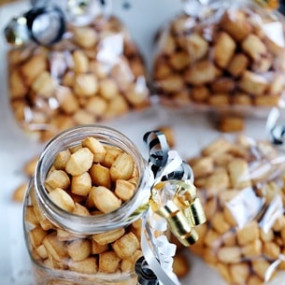TABLE OF CONTENT
CHAPTER ONE: INTRODUCTION
1.1 BACKGROUND
1.2 AIMS AND OBJECTIVES
1.3 SCOPE OF WORK
1.4 SIGNIFICANCE OF WORK
1.5 METHODOLOGY
CHAPTER TWO: LITERATURE REVIEW
2.1 INTRODUCTION
2.2 PHYSICAL AND CHEMICAL
PROPERTIES OF SHEA BUTTER
2.3 EXTRACTION OF SHEA BUTTER
2.5 PARAMETERS FOR OPTIMUM
KNEADING CONDITION
2.5.1 EFFECT OF SHAFT SPEED
2.5.2 EFFECT OF IMPELLER TYPE
2.5.3 EFFECT OF SHAFT
ECCENTRICITY
2.5.4 OTHER PARAMETERS OF
IMPORTANCE
2.5.5 THE ROLE OF BAFFLES
2.6 ROASTING AND MILLING
2.6.1 ROASTING
2.6.2 MILLING
CHAPTER THREE: METHODOLOGY
3.1 MATERIALS
3.2 FUNCTIONS OF THE EQUIPMENT
3.3 EXPERIMENTAL
PROCEDURE
CHAPTER FOUR: RESULT AND DISCUSSION
4.1 EFFECT OF TEMPERATURE ON
YIELD
4.2 EFFECT OF KNEADING PERIOD ON
THE TREND
4.3 KNEADING AT LOWER
TEMPERATURES
CHAPTER FIVE: CONCLUSION AND
RECOMMENDATION
5.1 CONCLUSIONS
5.2: RECOMMENDATIONS
Reference
CHAPTER ONE
INTRODUCTION
1.1 BACKGROUND
Shea butter has been a traditional heritage of Africa from time
immemorial. The triglyceride which contains a high amount of vitamin A, E, F
and some other valuable nutrients is widely used in cosmetics and
pharmaceuticals, as well as for domestic use in cooking. Nigeria (as well as
many other West African countries) is blessed with abundance of the shea tree
(from which the shea butter is obtained). Due to increasing demand for this
product, especially in the cosmetic industries across the globe, there is a
need for process optimization where
a high
yield of shea butter of good grade can be obtained with little energy input.
There are basically three methods
of obtaining shea butter from shea nut:
·
Solvent Extraction Method
·
Use of Mechanical Expeller
·
Traditional Method
Solvent extraction makes use chemical solvent such as hexane to absorb
the oil from the nut. The oil and the solvent are then separated in another
column.
In the mechanical expeller process, an expeller is force driven into the
nut contained in a tight container. As the expeller presses against the nut in
a screw manner, the oil are forced out and collected at the end.
The traditional method (in southwest Nigeria for example) typically
involves crushing of the nuts (after the outer flesh of the fruit has been
removed) with mortar and pestle. The crushed nuts are then roasted in a large
pot over an open fire (burning of fire wood). They are then ground and well
mixed to form a thick paste. The paste formed is kneaded by hand and leg in a
large container and with constant addition of water, the butter oil are
separated, melted in another pot and cooled.
Of these three methods, the traditional process gives the best quality
shea butter and it is by far the most preferred in the most industry. However,
this process requires a lot of rigorous exercises. According to Bonkoungou in
2005 for example, it would take one person 20 to 30 hours to produce 1kg of
shea butter. Also the level of personal and professional hygiene observed by
the local producers may render the locally made shea butter unfit for use in
areas such as pharmaceutical and chocolate industry. For example, in a research
by Ademola, Oyesola and Osewa of the Department of Agricultural Extension and
Rural Development, Faculty of Agriculture and Forestry, University of Ibadan
conducted on 120 local producers of shea butter from different Local
Governments Areas in Oyo state Nigeria, 95.8% of them do not actually wash the
fruit before use.
Although the mechanical expeller process may be preferred in terms of
energy saving, but it yields a denatured shea butter which can never compete in
terms of quality with the handmade type.
The solvent extraction process gives the highest yield since it is a
large scale industrial operation that may be adopted for commercial production.
However, it is too expensive as the cost of equipment and operation may be more
than the capacity of an individual. Also, the interaction of the solvent with
the oil still makes the shea butter formed be of lower quality than the locally
made product.
A good and sustainable process therefore must be one which can give high
yield of uncontaminated shea butter, retain the essential vitamin content and
at the same time less rigorous but economically feasible. One way of achieving
all these is by modeling the traditional method. Model equipment could be
fabricated using a stirrer or impeller to substitute the hand; thereby
increasing the efficiency, reducing contamination by hand without loss of
nutrients. In such modeling, a number of experiments must be carried out to
know the optimum condition of operation of the model equipment. Several
parameters must be tested for so as to obtain the best result; and according to
literature, these include: kneading time and temperature, impeller type, shaft
speed, eccentricity, etc.

Figure 1.1: Washed and dried shea nuts
1.2 AIMS AND OBJECTIVES
The aim of this research is to investigate the effect of kneading
temperature at selected kneading period on the yield of shea butter produced
from shea paste in an unbaffled vessel.
1.3 SCOPE OF WORK
This research measures the effect of three parameters on yield – shaft
eccentricity, shaft speed and impeller type. While eccentricity tries to
determine the best position of the stirrer relative to the center of the
vessel, the shaft speeds helps to determine the optimum speed of the stirrer
while the impeller type tells something on the nature or type of impeller to
use. Other parameters such as kneading time and temperature are not considered
here (a complementary work considering these two is being undertaken by another
student).
Also, the research measures the effect of these parameters only from the
kneading operation, (since this is the most important operation where the actual
separation takes place) so that the crushing, roasting and milling operations
are done prior to measurement, making work faster. The vessel being considered
for kneading is an unbaffled one. This is to avoid deposition of materials
inside the vessel which may affect the yield.
In all, this research narrows down to a system where the response can be
measured within a short while given different input, thus the use of shea paste
in an unbaffled vessel.
1.4 SIGNIFICANCE OF WORK
The significance of this research is the multiplier effect and the
potential to improve on the processing and thus yield of Shea nut as well as
help solve the problem of low quality of Shea butter produce in Nigeria. Some
of these are highlighted as follows:
(1)
It would help in determining the
best position of the stirrer shaft, as well as shaft speed and impeller type in
the vessel.
(2)
It would also help in the optimization of the
process and therefore better yield.
(3)
The quality of the product will improve and give
higher profit.
(4)
This will also mean more job for
more youth since the best method of processing has been known and can now be
fully explored on a large scale.
(5)
This will ultimately lead to
alternative revenue for the nation and less dependence on crude oil.
(6)
It would lead to increase in GDP
for Nigeria and therefore command respect among the comity of nations.
(7)
It would also make the hitherto
scarce quality shea butter readily available to all since buyers may not have
to travel down to rural communities before obtaining the product.
1.5 METHODOLOGY
This research shall proceed by selectively kneading at three different
kneading periods and at four range of temperature. Samples of Shea nuts shall
be exposed to the same treatment as it is done in the traditional method of
Shea butter production – crushing, roasting and milling. The parameters of
interest (kneading temperature and periods) shall then be experimented with a
fixed mass of shea paste at each run. The shaft speed shall be maintained at
968 rpm and the conical impeller shall be used throughout the experiments in
accordance with literature.
Click “DOWNLOAD NOW” below to get the complete Projects
FOR QUICK HELP CHAT WITH US NOW!
+(234) 0814 780 1594
Buyers has the right to create
dispute within seven (7) days of purchase for 100% refund request when
you experience issue with the file received.
Dispute can only be created when
you receive a corrupt file, a wrong file or irregularities in the table of
contents and content of the file you received.
ProjectShelve.com shall either
provide the appropriate file within 48hrs or
send refund excluding your bank transaction charges. Term and
Conditions are applied.
Buyers are expected to confirm
that the material you are paying for is available on our website
ProjectShelve.com and you have selected the right material, you have also gone
through the preliminary pages and it interests you before payment. DO NOT MAKE
BANK PAYMENT IF YOUR TOPIC IS NOT ON THE WEBSITE.
In case of payment for a
material not available on ProjectShelve.com, the management of
ProjectShelve.com has the right to keep your money until you send a topic that
is available on our website within 48 hours.
You cannot change topic after
receiving material of the topic you ordered and paid for.
![Business Plan]() Business Plan 19
Business Plan 19
![Case study]() Case study 0
Case study 0
![Feasibility Study]() Feasibility Study 44
Feasibility Study 44
![Software License]() Software License 6
Software License 6
![Training Manual]() Training Manual 2
Training Manual 2





























Login To Comment